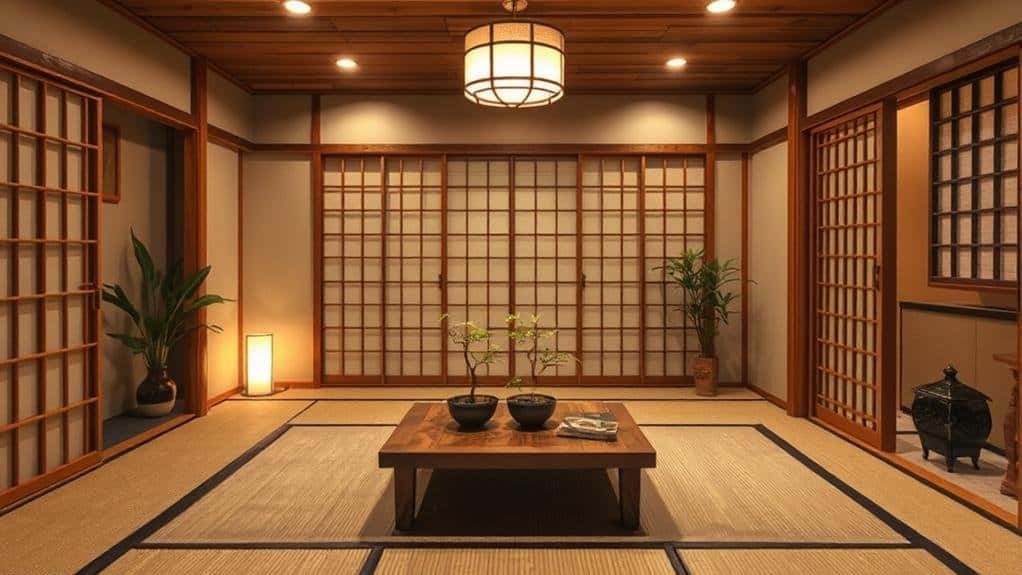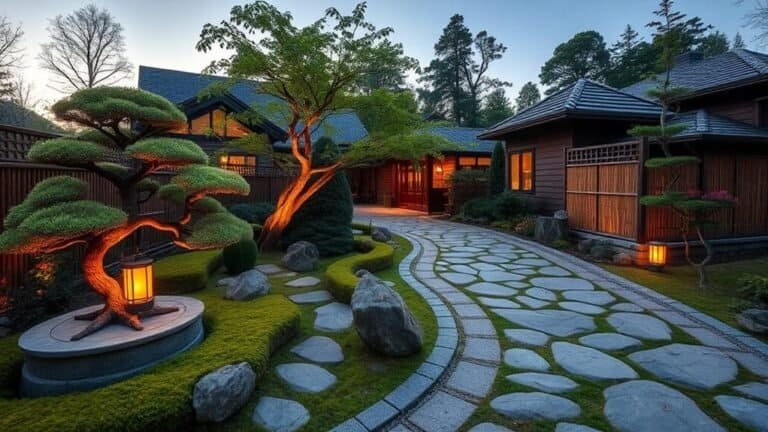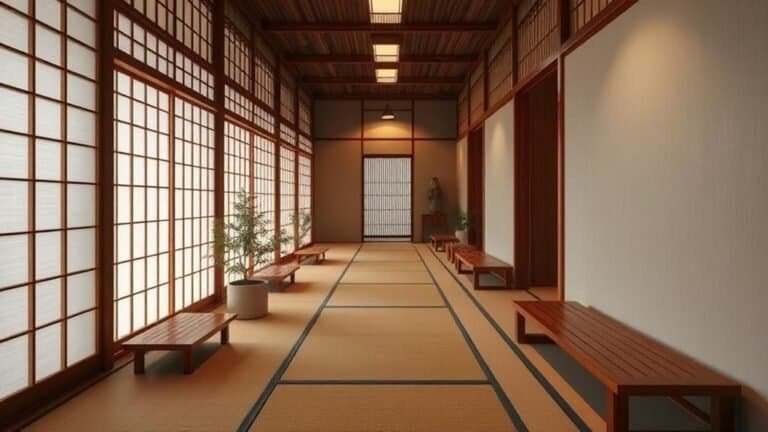To create a Japanese-style basement, focus on seven essential elements for a peaceful retreat. Start with natural materials like bamboo and reclaimed wood to add warmth. Embrace a minimalist aesthetic, using low-profile furniture that emphasizes function. Incorporate soft lighting through paper lanterns to create a relaxing atmosphere. Bring in indoor plants for air purification and a touch of nature. Choose a neutral color palette with soft whites and earthy tones for serenity. Include Zen elements, like a small water feature, and guarantee spaces are functional with multi-purpose furniture. Embrace these elements, and you'll discover a calming sanctuary. There's more to explore!
Key Takeaways
- Incorporate natural materials like wood, stone, and bamboo to create warmth and authenticity in the basement space.
- Embrace a minimalist aesthetic by selecting functional furniture and maintaining a clutter-free environment for serenity.
- Use soft lighting sources, such as paper lanterns or dimmable LEDs, to establish a warm and inviting atmosphere.
- Integrate indoor plants to enhance air quality and connect the space to nature, adding a calming influence.
- Utilize a neutral color palette with soft whites, beiges, and earthy tones to promote a peaceful retreat.
Natural Materials
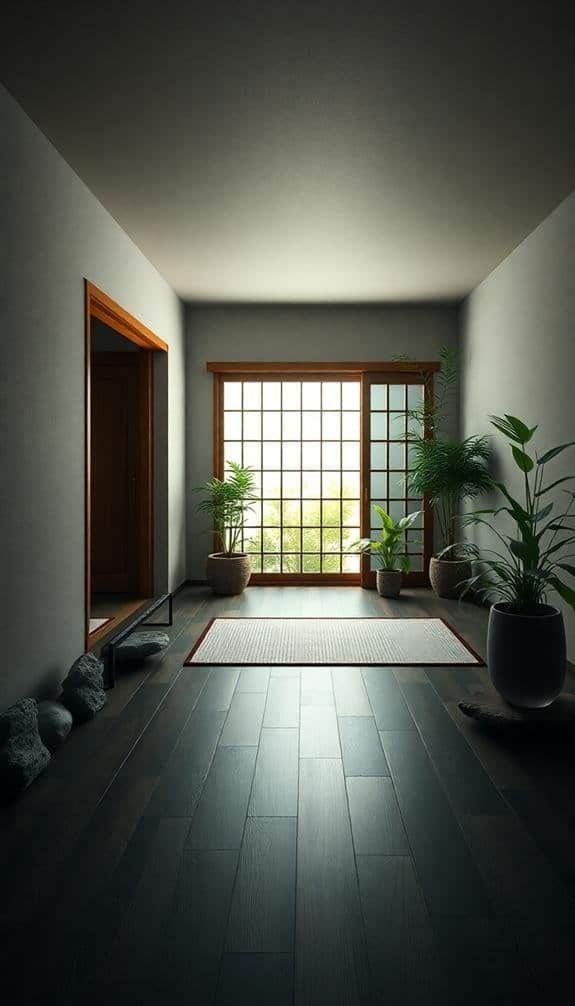
When you're designing a Japanese-style basement, incorporating natural materials is essential for creating a serene and inviting atmosphere. You'll want to focus on elements like wood, stone, and bamboo, which bring authenticity and warmth to your space. Using reclaimed wood for flooring or ceiling beams not only adds character but also promotes sustainability, a key principle in Japanese design. To further enhance your decor, consider adding Japanese kitchen decor essentials that align with your theme and elevate the overall aesthetic.
Consider stone accents, whether through a feature wall or a decorative pathway. Natural stones like slate or river rock can create a calming effect, enhancing the overall tranquil vibe. Additionally, incorporating bamboo—either as a structural element or decorative feature—invokes a sense of connection to nature that's crucial in Japanese aesthetics.
Textiles also play a role; opt for organic cottons or linens in neutral tones to complement your natural materials. These fabrics can soften the space, making it feel cozy and welcoming. Remember, the goal is to create a harmonious environment that encourages relaxation and mindfulness. By thoughtfully selecting and combining these materials, you'll craft a basement that reflects the beauty of nature while remaining innovative and functional. Embrace these ideas to transform your space into a serene retreat!
Minimalist Furniture
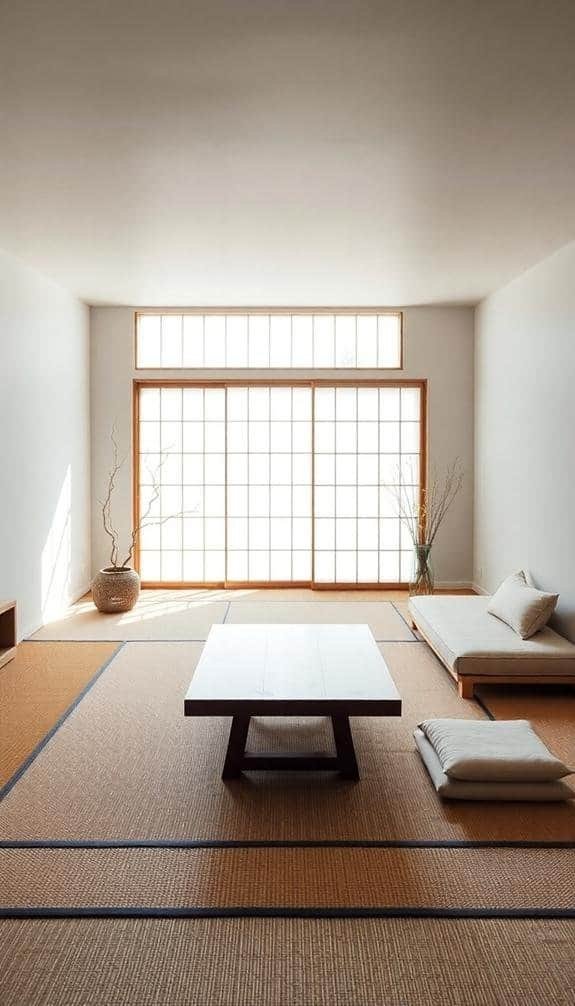
How can minimalist furniture enhance your Japanese-style basement? By embracing simplicity and function, minimalist furniture creates a serene environment that complements the natural beauty of Japanese design. Opt for low-profile pieces, like a sleek tatami mat or a simple wooden bench, which keep the space feeling open and airy. You might also consider selecting items from our curated collection of Japanese style decor, which emphasizes understated elegance.
You'll want to focus on clean lines and neutral colors to maintain that tranquil vibe. Consider incorporating multi-functional furniture, such as a coffee table that doubles as storage. This not only saves space but also reduces clutter, aligning perfectly with the minimalist ethos.
Incorporating natural materials like bamboo or reclaimed wood can further enhance the aesthetic, providing warmth and texture without overwhelming the senses. Keep your selections intentional—each piece should serve a purpose and contribute to the overall harmony of the room.
Lastly, think about scale. Choose furniture that fits the proportions of your basement, ensuring everything feels cohesive. With minimalist furniture, you're not just decorating; you're crafting an experience that invites relaxation and mindfulness. So, immerse yourself—transform your basement into a peaceful retreat that embodies the essence of Japanese style!
Soft Lighting
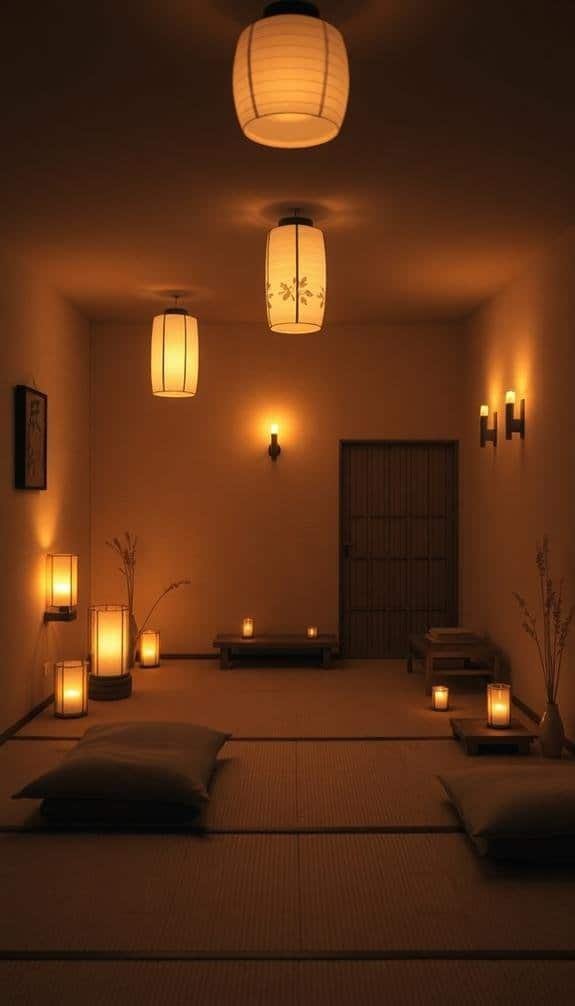
Soft lighting can transform your Japanese-style basement into a tranquil haven. By strategically using softer light sources, you create an inviting atmosphere that encourages relaxation and mindfulness. Consider incorporating paper lanterns or dimmable LED fixtures to enhance the serene vibe, as these elements are essential in Japanese style home office decor. They not only provide gentle illumination but also pay homage to traditional Japanese aesthetics.
You might also want to experiment with warm-toned bulbs, which mimic the golden glow of sunrise or sunset. This can evoke a sense of comfort and warmth, making your basement feel more like a cozy retreat. Layering your lighting is key; combine ambient lights with accent pieces to highlight artwork or architectural features.
If you're feeling adventurous, think about using sconces or even floor lamps with rice paper shades, which diffuse light beautifully and add an elegant touch.
Indoor Plants
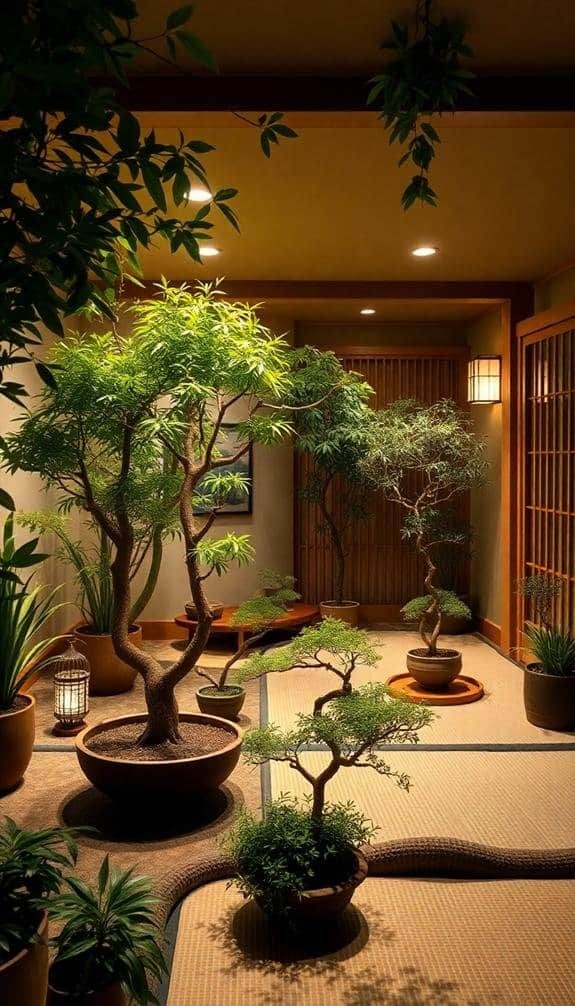
Adding indoor plants can further enhance the calming atmosphere of your Japanese-style basement. Incorporating greenery into your space not only beautifies it but also purifies the air. Consider integrating elements of Japanese style yard decor to create a seamless indoor-outdoor connection. Think about using low-maintenance plants like snake plants or peace lilies, which thrive in indirect light and require minimal care. These plants' sleek lines and elegant leaves complement the minimalist vibe of Japanese decor beautifully.
Consider grouping your plants in natural materials such as wooden pots or stone containers. This approach creates a harmonious connection with nature, emphasizing the tranquility that defines Japanese aesthetics. Placing plants near your soft lighting sources can cast delightful shadows, offering an ever-changing display throughout the day.
To elevate the innovation in your design, consider hanging plants or vertical gardens. This method adds dimension and draws the eye upward, making your basement feel more spacious. You might even explore bonsai trees, which carry a rich cultural significance and can serve as stunning focal points.
Neutral Color Palette
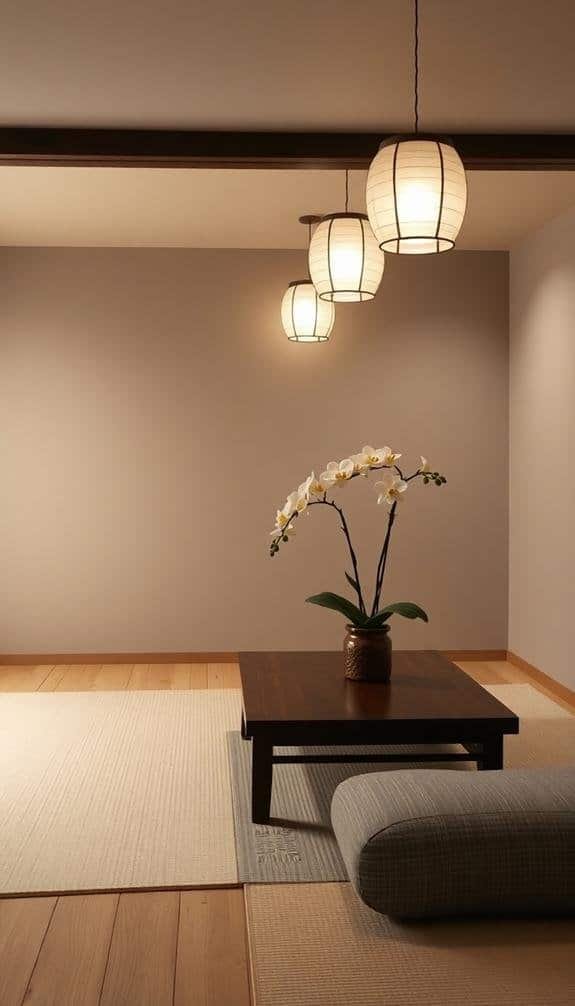
Embracing a neutral color palette is essential for achieving the serene atmosphere characteristic of Japanese-style basements. By opting for soft whites, gentle beiges, and muted grays, you can create a calming environment that feels both inviting and spacious. These hues not only reflect light but also serve as a perfect backdrop for the natural elements you'll want to incorporate.
When choosing your colors, think about how they work together. Layering different shades can add depth and interest without overwhelming the senses. For instance, a light gray wall paired with creamy white trim can create a sophisticated yet tranquil space. You might even consider using textured materials, like a smooth silk throw or a woven rug, to add subtle variations within this palette.
To break up the monotony, introduce occasional splashes of earthy tones, such as soft greens or warm browns, which can enhance the connection to nature that's so crucial in Japanese decor. Remember, the goal is to achieve harmony and balance. By focusing on a neutral palette, you'll cultivate a peaceful retreat that invites relaxation and contemplation, making your basement a true sanctuary.
Zen Elements
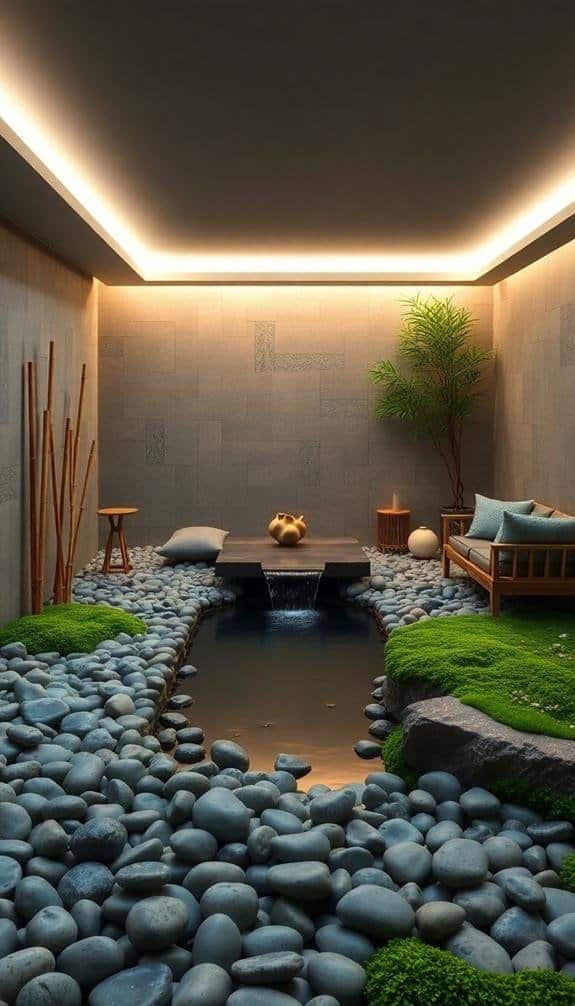
Incorporating Zen elements into your basement decor can transform the space into a tranquil retreat. Start by introducing natural materials like bamboo, stone, and wood. These elements not only enhance the aesthetic but also promote a sense of calm. Consider bamboo accents, whether in furniture or decorative pieces, to evoke a serene atmosphere.
Next, focus on minimalism. Remove any clutter that disrupts the peace you're aiming to create. A few well-chosen items, like a simple vase or a hand-carved statue, can make a strong statement without overwhelming the senses.
Lighting plays an essential role too. Opt for soft, warm lights, or even candles to bring a gentle glow that encourages relaxation.
You can also incorporate a small indoor water feature, like a tabletop fountain, to add soothing sounds that enhance your Zen space. Finally, bring in greenery. A few carefully placed plants can purify the air and connect your basement to nature.
Functional Spaces
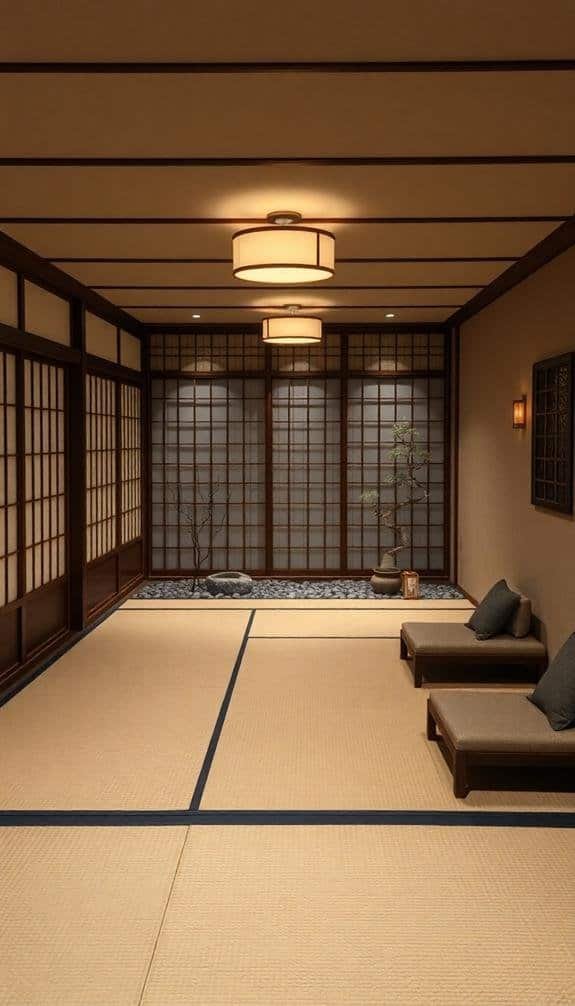
Creating functional spaces in your Japanese-style basement means blending practicality with aesthetic appeal. You can turn this often-overlooked area into a versatile sanctuary that serves multiple purposes while maintaining harmony and simplicity. Start by identifying key areas that define functionality.
Here are three essential elements to contemplate:
- Multi-Purpose Zones: Design spaces that can serve various functions. For example, a quiet reading nook could also double as a meditation area. Use modular furniture to maximize flexibility.
- Natural Light Enhancement: If possible, incorporate windows or skylights to invite natural light into your basement. Light, airy spaces uplift the mood and create a sense of openness, crucial in Japanese design.
- Storage Solutions: Utilize hidden storage to keep your space clutter-free. Built-in shelves or clever under-bench storage can maintain a minimalist aesthetic while providing room for essentials.

